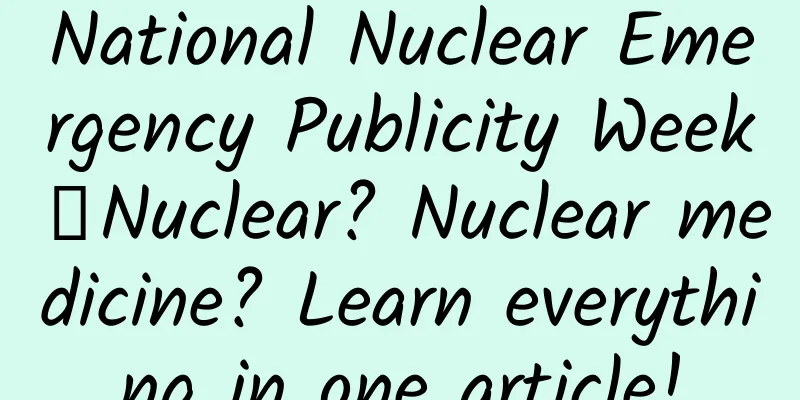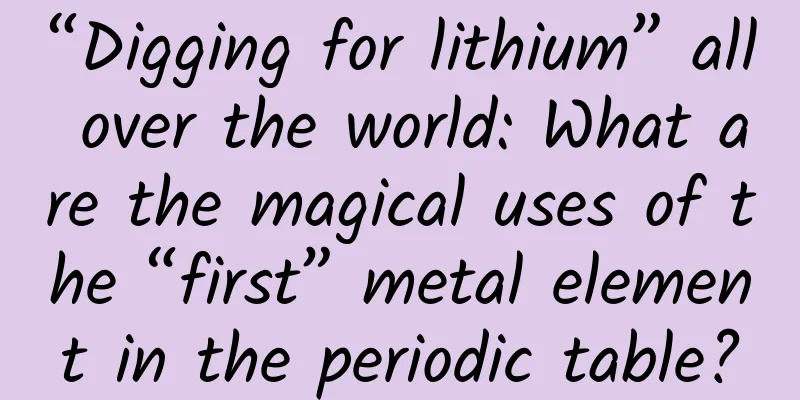National Nuclear Emergency Publicity Week丨Nuclear? Nuclear medicine? Learn everything in one article!

|
In the hospital, when many patients receive the examination form written by the doctor and see the words "nuclear medicine", they often feel unfamiliar and even have a hint of fear. "Nuclear? Nuclear medicine?" “Will there be radiation? "The nuclear medicine test must be very harmful to me, right?" Don’t panic! Don’t be afraid! Today we invite Dr. Hao Zhixin from the Department of Nuclear Medicine at Peking Union Medical College Hospital to reveal the secrets of nuclear medicine. The “Soul” of Nuclear Medicine——Radionuclide Nuclear medicine is a discipline that uses radionuclides to diagnose, treat diseases and conduct medical research. Radionuclides are the "soul" of nuclear medicine. Radionuclides are substances that can emit various rays through spontaneous decay. There are three common types of rays: alpha rays, beta rays and gamma rays. α **** rays have the worst penetrating power, and a piece of A4 paper can block them, but their ionizing power (ionization can cause damage to substances in the body's cells) is the greatest among the three rays. It is particularly easy to protect against α rays outside the body, but if α rays enter the body, they will cause greater radiation damage to surrounding tissues. The penetrating power of β rays is stronger than that of α rays, but the ionizing power is weaker than that of α rays. Ordinary metal plates or organic glass plates with a certain thickness can block β rays. Since β rays have certain penetrating power and ionizing power, both internal and external β rays will cause radiation damage to human tissues. Gamma rays have the strongest penetrating power among the three rays and can indirectly cause ionization by interacting with matter. To effectively block gamma rays, thick concrete walls or heavy metal plates are generally required. ▲Different rays can be shielded by different materials. A piece of paper can block alpha rays; ordinary metals can block beta rays; and lead, reinforced concrete, etc. are needed to block gamma rays. There are many types of radionuclides, so what kind of radionuclides can be used in nuclear medicine for disease diagnosis and treatment? In simple terms, radionuclides that emit gamma rays (such as 99mTc technetium, 131I iodine) and beta+ rays (such as 18F fluorine, 68Ga gallium, 11C carbon) are suitable for imaging and disease diagnosis, while radionuclides that emit alpha rays (such as 225Ac actinium, 223Ra radium) and beta- rays (such as 32P phosphorus, 89Sr strontium, 90Y yttrium, 131I iodine, 177Lu lutetium) are suitable for disease treatment. Of course, the selection of radionuclides also needs to take into account factors such as ray energy and half-life. The “unique skill” of nuclear medicine: radiopharmaceuticals Radiopharmaceuticals are generally made of radionuclides and labeled substances . The labeled substances can be compounds, blood components, peptides, hormones, monoclonal antibodies, etc. The targeting of the labeled substances determines the destination of the radiopharmaceuticals in the human body, thereby achieving the purpose of specific diagnosis and treatment of diseases. For example: Tumor cells grow fast and need a lot of glucose to provide energy. FDG (fluorodeoxyglucose) is an analog of glucose. After 18F and FDG are "inlaid" into 18****F-FDG, it can image tumor cells throughout the body, thereby diagnosing and staging the disease. Somatostatin receptors (SSTR) are highly expressed on the surface of neuroendocrine tumor cells. Octreotide can specifically bind to SSTR. 99mTc-Octreotide obtained by labeling Octreotide with 99mTc can perform non-invasive diagnosis of neuroendocrine tumors after entering the human body. Thyroid tissue and thyroid cancer cells can absorb 131****I . Since 131 I can emit both gamma rays and beta rays at the same time, after 131 I enters the human body, it can not only be used for thyroid (cancer) imaging, but can also be used to treat hyperthyroidism and thyroid cancer. ▲ Radioactive nuclides and labeled substances are “embedded” to form radioactive drugs, which specifically bind to cells after entering the human body. === What does a nuclear medicine examination check? Nuclear medicine examination is a medical imaging method that introduces radioactive drugs into the human body and uses different "detectors" to detect the rays emitted by the radionuclides for imaging. Conventional imaging examinations, such as ultrasound, CT, MRI, etc., mainly show the morphological changes of organs or tissues. In layman's terms, it is to see where the lesions grow, what they look like, how big they are, and so on. Nuclear medicine examinations can not only display the anatomical information of lesions, but more importantly, they can reflect changes in the blood flow, function, metabolism and even molecular levels of organs and lesions, thereby showing lesions at the stage when there are only functional changes but no morphological and structural abnormalities, thereby achieving early diagnosis of the disease. One of the “detectors” of nuclear medicine—— PET/CT The most well-known nuclear medicine "detector" is PET/CT . PET/CT is currently the most advanced molecular imaging examination. The most commonly used radioactive drug for PET/CT is 18F-FDG, which can provide "one-stop services" such as early diagnosis, staging, efficacy evaluation, and prognosis evaluation of tumors. 18F-FDG PET/CT can also be used to evaluate whether the myocardium in the infarction site is viable, providing a definite basis for the treatment of coronary heart disease. In addition, epilepsy, dementia, infectious diseases, rheumatic immune diseases, etc. also need the help of 18F-FDG PET/CT. In addition to 18F-FDG, nuclear medicine also has some more specific radioactive drugs for a variety of diseases, such as 68 Ga- or 18 F-PSMA (prostate-specific membrane antigen) for prostate cancer, 18F-FES (estrogen analog) for estrogen receptor-positive breast cancer, 68Ga-DOTATATE (somatostatin analog) for neuroendocrine tumors, etc. ▲PET/CT examination The second "detector" of nuclear medicine - SPECT Another "detector" in nuclear medicine is SPECT . Compared with PET/CT, SPECT can be regarded as the "three-generation veteran" in the field of nuclear medicine. Although SPECT is unknown, it uses a wide variety of radioactive drugs and a wide variety of examination items, involving various organs and systems of the human body. For example, bone imaging can be used to image bones throughout the body, and can be used to diagnose bone metastasis of malignant tumors at an early stage, or to detect osteoarthritis and degenerative lesions; dynamic renal imaging can evaluate renal function non-invasively; myocardial perfusion imaging can determine the blood supply of the coronary arteries to the myocardium, and is an important examination method for the early diagnosis of coronary heart disease; pulmonary perfusion imaging can reflect the blood supply to the lungs, and is a common method for the early diagnosis and differentiation of pulmonary embolism; thyroid imaging can understand the morphology, size, location and function of the thyroid gland, and help determine whether thyroid nodules are benign or malignant. ▲Common radioactive drugs and examination items of SPECT in nuclear medicine How much radiation does a nuclear medicine examination emit? Nuclear medicine examinations involve radiation, so does it mean that as long as a nuclear medicine examination is done, it will cause damage to the body or even cause cancer? In fact, in addition to the radiation in the radiology and nuclear medicine departments of hospitals, radiation is everywhere in life. The food we eat every day, the houses around us, the sky, the earth, the mountains, rivers and plants all have a certain amount of radiation . Low-dose, short-term radiation is not enough to affect physical health, and high-dose radiation that can damage the human body is difficult for us to come into contact with in daily life. The radioactive nuclides used in nuclear medicine examinations decay very quickly (such as 99mTc, 18F, 68Ga, etc.). The radiation dose received from a nuclear medicine 18F-FDG PET examination is roughly equivalent to that from a chest CT examination. The radiation dose generated by most nuclear medicine examinations is even lower than that from a chest CT examination. There is no need to look at nuclear medicine examinations with " tinted glasses ". All nuclear medicine examinations performed by patients for the purpose of diagnosing and treating diseases are safe. ▲Radiation is everywhere in life The “trump card” of nuclear medicine——precision treatment Nuclear medicine therapy is the process of introducing therapeutic radioactive drugs into the human body and using the beta rays or alpha rays emitted by the radioactive nuclides to very accurately destroy and kill diseased or tumor cells. Nuclear medicine treatment has great advantages in thyroid diseases and multiple bone metastases. Iodine is one of the raw materials for the thyroid gland to synthesize thyroid hormones, so thyroid cells can absorb 131I. 131I can not only be used to treat hyperthyroidism caused by Graves' disease, toxic multinodular goiter and thyroid toxic adenoma, but also to treat differentiated thyroid cancer . Its main function is to remove residual thyroid tissue and hidden metastatic lesions after surgery. The average range of the β-rays emitted by 131I in the body is only 1 mm, and the energy of the β-rays is almost entirely confined to the lesions, so it has little effect on surrounding normal tissues and organs. ▲131I treatment of hyperthyroidism caused by Graves' disease In addition to the use of 131I for thyroid diseases, there are many other nuclear medicine treatment projects in clinical practice. The metabolism of bone tissue at the site of tumor bone metastasis is very active, and it can absorb more radioactive drugs (such as 89SrCl2, 223RaCl2, etc.) used to treat bone metastasis, thereby achieving the purpose of controlling disease progression and alleviating bone pain. Pheochromocytoma and neuroblastoma can highly selectively take up 131I-MIBG, so 131I-MIBG can be used to treat patients who are inoperable or have recurrence and metastasis after surgery. The use of 32P applicators to treat capillary hemangiomas and keloids is also one of the traditional nuclear medicine treatments. Under the guidance of surgery or imaging, radioactive particles are implanted into tumor tissues, which can continuously kill tumors and shrink them. In recent years, 177Lu-PSMA has also achieved very good therapeutic effects in patients with advanced prostate cancer , and 177Lu-DOTATATE has also achieved very good therapeutic effects in patients with advanced neuroendocrine tumors . Nuclear medicine uses radioactive drugs to reflect the molecular, metabolic and functional status of lesions. It can not only provide insights into changes in the molecular information of lesions through imaging, but also use radiation to accurately kill tumors. "Nuclear" has played an increasingly important role in the fields of energy, medicine, science and technology, industry and agriculture. We should look at "nuclear" with a scientific attitude so that "nuclear" can better serve us. ▌The popular science theme of this article comes from the special issue "Nuclear Diagnosis and Treatment and Clinical Transformation" of "Journal of Peking Union Medical College" in Issue 4, 2023 Editor: Liu Yang and Zhao Na Proofreading: Li Na, Li Yule, Dong Zhe, Li Huiwen Producer: Wu Wenming 【Copyright Statement】 "Pumch Medical Journal" advocates respecting and protecting intellectual property rights. Reprinting and quoting are welcome, but authorization from this platform is required. If you have any questions about the content and copyright of the article, please send an email to [email protected], and we will communicate with you in a timely manner. The graphic content is for communication and learning only, not for profit; the popular science content is only used to popularize public health knowledge. Readers should not use it as a basis for individual diagnosis and treatment, and do not dispose of it on their own to avoid delaying treatment. For medical treatment, please visit the Peking Union Medical College Hospital APP online or offline. |
<<: Why are rats the “beneficiaries” of floods?
>>: 40℃ is not over yet! This summer may be hotter than ever before!
Recommend
2 tips to double your conversion rate! Which one have you used?
In previous articles, Qingguajun has always empha...
Is it expensive to invest in the Xiangxi Entertainment Mini Program? Xiangxi Entertainment Mini Program Investment Fees and Process
What is the investment cost of Xiangxi Entertainm...
The mysterious archaea discovered by accident can "revive" old oil fields
Methanogens are a type of bacteria that use metha...
A comprehensive summary of Xigua Video live selling skills!
Summary of Xigua Video live streaming sales techn...
The Winter Olympics menu is out! These common ingredients contain stimulants, so don't eat them!
Expert of this article: Chu Yuhao, PhD of Beijing...
What to do if you have too much lucky money? Do you know how to withdraw money from WeChat without handling fee?
[[382126]] The long-awaited Spring Festival holid...
Planting trees at an altitude of 3,600 meters, the barren mountains are turning green!
"Gelsang flowers are in bloom, trees are lus...
WeChat and Alipay personal payment codes are disabled. Does this have any impact on ordinary users?
There are different interpretations on the Intern...
These 30 copywriting sentences are worth 30,000
Different classic copywriting has the same senten...
Money is too easy to make: Apple and Google's app store "taxes" spark public outrage
Beijing time, August 23, morning news, more and m...
The booster behind the location-based security smart hardware
If you have seen the movie "Dear", you ...
New US President's policy: Apple and Intel will have a hard time in China
According to CNNMoney, a financial website under ...
Kaola.com Product Analysis
Kaola.com (formerly known as NetEase Kaola) is an...
The world’s largest clean energy corridor, what are the “world’s best”?
As the world's largest clean energy corridor ...

![Chen Naiba's Douyin Book List Performance Course, the core skills and operating standards for quickly starting an account [Video Course]](/upload/images/67cc29ea1fbef.webp)







